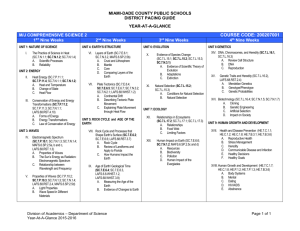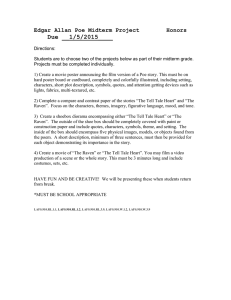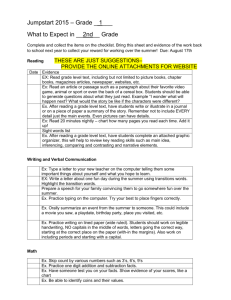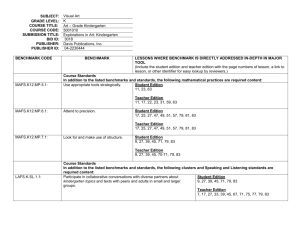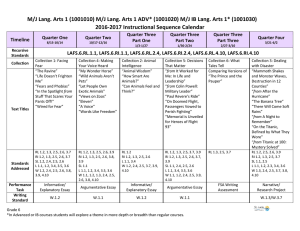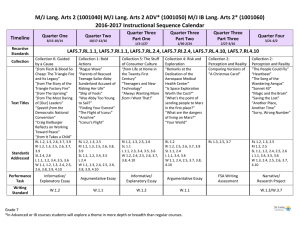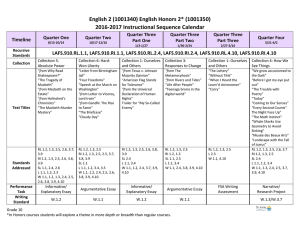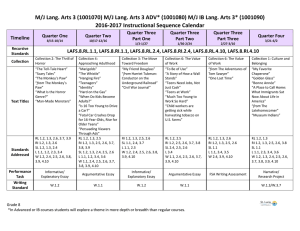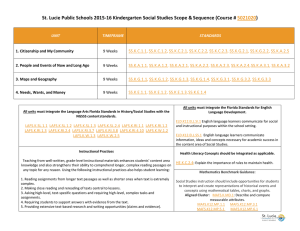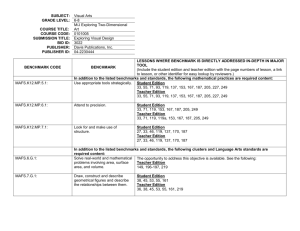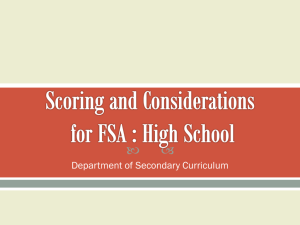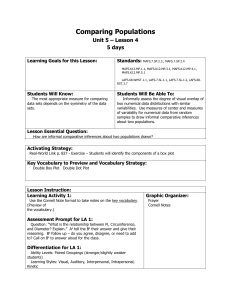Explorations in Art: A Global Pursuit
advertisement
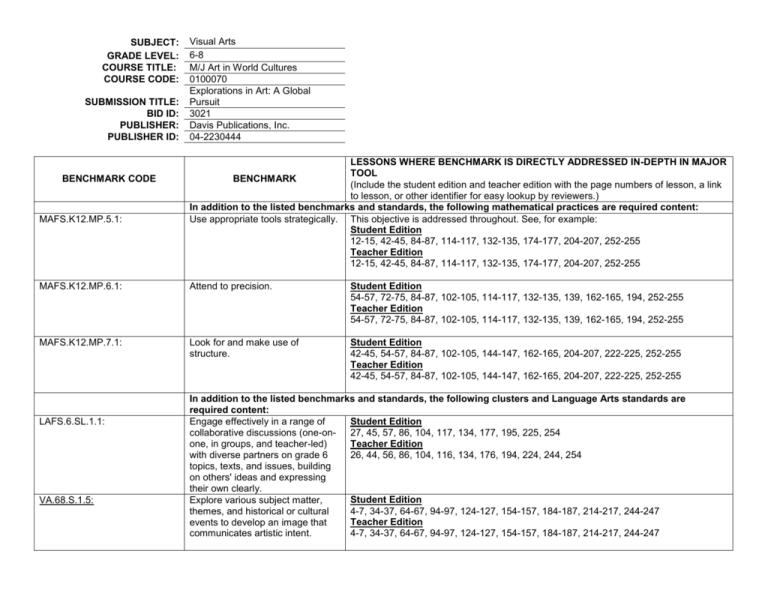
SUBJECT: GRADE LEVEL: COURSE TITLE: COURSE CODE: SUBMISSION TITLE: BID ID: PUBLISHER: PUBLISHER ID: BENCHMARK CODE MAFS.K12.MP.5.1: Visual Arts 6-8 M/J Art in World Cultures 0100070 Explorations in Art: A Global Pursuit 3021 Davis Publications, Inc. 04-2230444 LESSONS WHERE BENCHMARK IS DIRECTLY ADDRESSED IN-DEPTH IN MAJOR TOOL BENCHMARK (Include the student edition and teacher edition with the page numbers of lesson, a link to lesson, or other identifier for easy lookup by reviewers.) In addition to the listed benchmarks and standards, the following mathematical practices are required content: Use appropriate tools strategically. This objective is addressed throughout. See, for example: Student Edition 12-15, 42-45, 84-87, 114-117, 132-135, 174-177, 204-207, 252-255 Teacher Edition 12-15, 42-45, 84-87, 114-117, 132-135, 174-177, 204-207, 252-255 MAFS.K12.MP.6.1: Attend to precision. Student Edition 54-57, 72-75, 84-87, 102-105, 114-117, 132-135, 139, 162-165, 194, 252-255 Teacher Edition 54-57, 72-75, 84-87, 102-105, 114-117, 132-135, 139, 162-165, 194, 252-255 MAFS.K12.MP.7.1: Look for and make use of structure. Student Edition 42-45, 54-57, 84-87, 102-105, 144-147, 162-165, 204-207, 222-225, 252-255 Teacher Edition 42-45, 54-57, 84-87, 102-105, 144-147, 162-165, 204-207, 222-225, 252-255 LAFS.6.SL.1.1: VA.68.S.1.5: In addition to the listed benchmarks and standards, the following clusters and Language Arts standards are required content: Student Edition Engage effectively in a range of collaborative discussions (one-on- 27, 45, 57, 86, 104, 117, 134, 177, 195, 225, 254 Teacher Edition one, in groups, and teacher-led) with diverse partners on grade 6 26, 44, 56, 86, 104, 116, 134, 176, 194, 224, 244, 254 topics, texts, and issues, building on others' ideas and expressing their own clearly. Student Edition Explore various subject matter, themes, and historical or cultural 4-7, 34-37, 64-67, 94-97, 124-127, 154-157, 184-187, 214-217, 244-247 Teacher Edition events to develop an image that communicates artistic intent. 4-7, 34-37, 64-67, 94-97, 124-127, 154-157, 184-187, 214-217, 244-247 Determine the meaning of symbols, key terms, and other domain-specific words and phrases as they are used in a specific scientific or technical context relevant to grades 6–8 texts and topics. Identify the function of structural elements of art and organizational principles of design to create and reflect on artwork. Student Edition 30, 60, 90, 120, 150, 210, 240, 270 Teacher Edition 30, 60, 90, 120, 150, 210, 213, 240, 270 VA.68.O.3.2: Discuss the communicative differences between specific twoand three-dimensional works of art. Student Edition 158-161, 218-221 Teacher Edition 158-161, 218-221 VA.68.H.1.3: Analyze and describe the significance of artwork from a selected group or culture to explain its importance to the population. Describe how previous cultural trends have led to the development of new art styles. Student Edition 20-23, 50-53, 80-83, 110-113, 140-143, 170-173, 200-203, 230-233, 260-263 Teacher Edition 20-23, 50-53, 67, 80-83, 110-113, 140-143, 170-173, 200-203, 230-233, 260-263 Discuss the use of background knowledge and critical-thinking skills, learned in the visual arts, to understand varying concepts, viewpoints, and solutions. Remarks/Examples: e.g., identify facts, ideas, problem-solving skills Identify art careers that have a financial impact on local communities. Teacher Edition 6, 15, 25, 45, 75, 81, 105, 135, 143, 165, 190, 195, 235, 255 *See Writing Process Connection LAFS.68.RST.2.4: VA.68.O.1.2: VA.68.H.2.1: VA.68.H.3.2: VA.68.F.2.3: VA.68.F.3.1: Use technology applications through the art-making process to express community or global concerns. Student Edition 8-9, 38-39, 50-52, 68-69, 112, 158-160, 188-191 Teacher Edition 8-9, 38-39, 50-52, 68-69, 112, 158-160, 188-191 Student Edition 16-19, 46-49, 76-79, 106-109, 136-139, 166-169, 196-199, 226-229, 256-259 Teacher Edition 16-19, 46-49, 76-79, 106-109, 136-139, 166-169, 196-199, 226-229, 256-259 The opportunity to address this objective is available. See the following: Student Edition 89, 119, 149, 179, 209, 239, 269 Teacher Edition 89, 119, 149, 179, 209, 239, 269 *Financial impact on local communities is not specifically addressed. Teacher Edition 11, 26, 56, 116, 205 *See Computer Option VA.68.C.1.2: Use visual evidence and prior knowledge to reflect on multiple interpretations of works of art. This objective is addressed throughout. See, for example: Student Edition 15, 27, 45, 57, 74, 86, 104, 117, 134, 146, 165, 177, 195, 207, 225, 237, 254, 267 Teacher Edition 15, 26, 44, 56, 74, 86, 104, 116, 134, 146, 164, 176, 194, 206, 224, 236, 256, 266 VA.68.C.3.2: Examine and compare the qualities of artworks and utilitarian objects to determine their aesthetic significance. Remarks/Examples: e.g., comparison, classification, cause and effect, reasoning, hypothesizing, critiquing Interpret information presented in diverse media and formats (e.g., visually, quantitatively, orally) and explain how it contributes to a topic, text, or issue under study. Student Edition 30-31, 60-61, 90-91, 120-121, 150-151, 180-181, 210-211, 240-241, 270-271 Teacher Edition 30-31, 60-61, 90-91, 120-121, 150-151, 180-181, 210-211, 240-241, 270-271 LAFS.6.SL.1.2: Student Edition 28, 58, 88, 118, 148, 178, 208, 238, 268 Teacher Edition 11, 15, 28, 58, 75, 79, 88, 101, 118, 119, 131, 139, 148, 165, 178, 181, 208, 214, 238, 268 *See Assessment Option and Connections to other disciplines The opportunity to address this objective is available. See the following: Student Edition 30, 60, 90, 120, 150, 180, 210, 240 Teacher Edition 19, 27, 30, 57, 60, 90, 101, 113, 120, 150, 180, 199, 210, 240, 255 LAFS.68.WHST.2.4: Produce clear and coherent writing in which the development, organization, and style are appropriate to task, purpose, and audience. VA.68.C.3.4: Compare the uses for artwork and utilitarian objects to determine their significance in society. The opportunity to address this objective is available. See the following: Student Edition 10, 21, 35, 37, 39, 50, 110-111, 124, 138, 144-145, 185, 211, 213, 231 Teacher Edition 10, 21, 25, 35, 37, 39, 50, 110-111, 124, 138, 144-145, 185, 211, 213, 231 *Utilitarian art pieces are shown, but comparing and their significance on society is not specifically addressed. LAFS.6.SL.1.3: Delineate a speaker’s argument and specific claims, distinguishing claims that are supported by reasons and evidence from claims that are not. Present claims and findings, sequencing ideas logically and using pertinent descriptions, facts, and details to accentuate main ideas or themes; use appropriate eye contact, adequate volume, and clear pronunciation. The opportunity to address this objective is available. See the following: Teacher Edition 119, 149 *Speakers visit the class, but delineation of argument and claims is not specifically addressed. Teacher Edition 154, 196, 237 LAFS.6.SL.2.4: LAFS.68.WHST.2.6: LAFS.68.WHST.3.7: VA.68.S.1.4: Use technology, including the Internet, to produce and publish writing and present the relationships between information and ideas clearly and efficiently. Conduct short research projects to answer a question (including a self-generated question), drawing on several sources and generating additional related, focused questions that allow for multiple avenues of exploration. Use accurate art vocabulary to explain the creative and artmaking processes. The opportunity to address this objective is available. See the following: Teacher Edition 30, 60, 90, 120, 150, 180, 210, 240 Student Edition 263 Teacher Edition 46, 47, 49, 82, 83, 87, 108, 126, 156, 168, 173, 174, 177, 186, 202, 243, 259 Student Edition 15, 30, 45, 60, 75, 90, 105, 120, 135, 150, 165, 180, 195, 210, 225, 240, 255 Teacher Edition 15, 30, 45, 60, 75, 90, 105, 120, 135, 139, 150, 165, 180, 187, 195, 210, 225, 240, 249, 255
